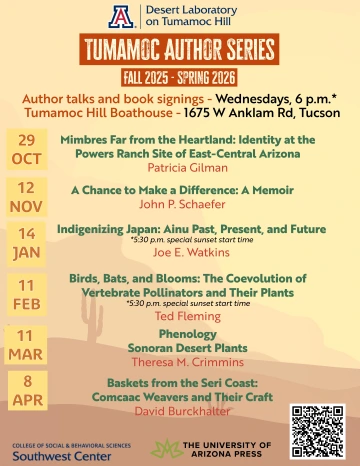When

Welcome to the Fall 2025–Spring 2026 Tumamoc Author Series, a collaboration between the Desert Laboratory on Tumamoc Hill, the Southwest Center, and the University of Arizona Press.
Each season, as the sun gives us a well-deserved break and shadows stretch across ancient Tumamoc Hill, we gather to hear from writers whose work captures the spirit, complexity, and wonder of the Southwest. This year’s lineup continues that tradition, featuring authors who challenge, illuminate, and celebrate the landscapes and cultures of our shared region. Join us for evenings of conversation, reflection, and community in one of Tucson’s most storied places.

On October 29, archaeologist Patricia Gilman takes us back 900 years when the Mimbres culture flourished in eastern Arizona. She will talk about her new book, co-authored with Mary Whisenhunt: Mimbres Far from the Heartland: Identity at the Powers Ranch Site of East-Central Arizona. Mimbres culture is famous for its black-on-white pottery and large, compact pueblo villages. Through excavation and analysis of architecture and a rich array of artifacts, including ceramic sherds, projectile points, and shell artifacts, Gilman and Whisenhunt provide a detailed look at the lives of Mimbres people on the periphery. Gilman will be in conversation with Linda Gregonis, co-author with Victoria Riley Evans of The Hohokam and Their World. RSVP HERE
For the November 12 talk, we take you behind the scenes at the University of Arizona with John Schaefer, former president of the U of A. In this preview of his new book, A Chance to Make a Difference: A Memoir, find out how Schaefer’s passion for photography and conservation seamlessly coexisted with his pursuit of academic excellence. He will also tell stories of the cutthroat competition that is birdwatching in Tucson and explain why Arizona has a longer bird checklist than any other landlocked state. He will be in conversation with Ken Lamberton, author of Chasing Arizona. Unfortunately- this Event has been Cancelled.
January 14: How does the Ainu experience in Hokkaido, Japan relate to other Indigenous people in the context of global colonialism? Joe E. Watkins’ earlier anthropology work with Indigenous communities in the United States allows him to answer this question. He will talk about his new book, Indigenizing Japan: Ainu Past, Present, and Future, which investigates the rich history and cultural resilience of the Ainu, tracing their journey from ancient times to their contemporary struggles for recognition. As a member of the Choctaw Nation of Oklahoma, Watkins’ interests concern the ethical practice of anthropology and anthropology’s relationships with descendant communities and populations on a global scale. RSVP HERE
For the February 11 event, hummingbirds are the stars of the show. See beautiful photographs of birds, bats, and the flowers that they pollinate. Ted Fleming will speak about his book, Birds, Bats, and Blooms: The Coevolution of Vertebrate Pollinators and Their Plants. Fleming spent thirty-nine years in academia at the University of Missouri–St. Louis and the University of Miami, teaching ecology courses and conducting research on tropical rodent populations and plant-visiting bats and their food plants in Panama, Costa Rica, Australia, Mexico, and Arizona. He will be in conversation with Tucson bee expert, Steven Buchmann. RSVP HERE
March 11: What can the seasonal rhythms of plants and animals tell us about the health of our world—and our own well-being? Theresa Crimmins, director of the USA National Phenology Network and Associate Professor at the University of Arizona, will explore these questions, as outlined in her new book Phenology (MIT Press, 2025). With warmth and scientific clarity, Crimmins introduces the audience to the study of life cycle timing in nature, from leaf-out to migration, and shows how paying attention to these patterns deepens our connection to place while informing climate science. She invites us to become everyday phenologists and take part in a joyful, urgent practice that supports both mental health and environmental stewardship. RSVP HERE
For our final lecture, on April 8, documentary photographer David Burckhalter will share stunning images of Seri (Comcaac) baskets and the women who make them. His book, Baskets from the Seri Coast: Comcaac Weavers and Their Craft, traces the evolution of Seri basketry from a utilitarian craft to a celebrated art form. Burckhalter has spent five decades cultivating friendships and documenting Seri traditions, landscapes, and basketry in Sonora, Mexico. With detailed insights into the artistry, labor, and legends surrounding Seri baskets, Burckhalter’s images pay tribute to the resilience and creativity of Seri women, whose weaving continues to be passed on to future generations. RSVP HERE

